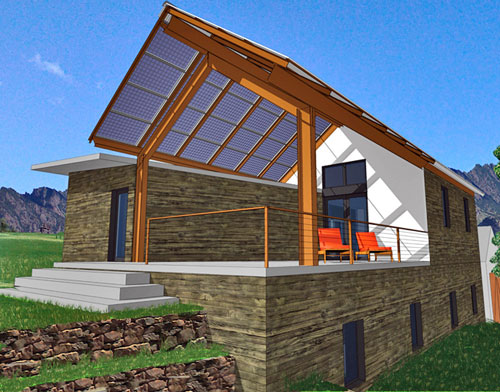Low Energy, but High Impact
House of straw (and foam)
Boulder, Colorado-based architect Brian Fuentes has six Passive House projects on the boards, including a home he is building for himself on the outskirts of the city from the remnants of a dilapidated 1880 miner's house. He is using an unusual modular system in which straw bales are set into a braced wooden frame and arrive at the site as prefinished wall units. The roof will be made of structural insulated panels (SIPs) supported by glue-laminated beams. Since SIPs are made of solid-foam panels with sheathing bonded to the exterior surfaces, they are a good material for reducing thermal bridging. Also, because SIPs interlock at the edges, they help make the building airtight.
 |
Architect Brian Fuentes is building a Passive House for himself on the outskirts of Boulder, Colorado, that combines a modular straw-bale and braced-frame system with structural insulated panels. Rendering: courtesy Fuentesdesign |
Â
Unlike LEED, Passive House focuses solely on reducing energy consumption. It has no requirements for water conservation or sustainable site development, for example. Fuentes prefers the Passive House system. "LEED has done a good job of getting the idea of green building out there, but Passive House fills in the energy performance side," he says.
Instead of LEED's matrix of points, Passive House certification relies on PHIUS verification in the three benchmark areas. A blower door test is required to demonstrate compliance with the air-infiltration standard, while a software program included in PHIUS's PHPP analyzes the Btu and electrical-consumption levels. Some components such as ERVs and windows are pretested and certified by the Iinstitute. But others need to be analyzed in the PHPP. For example, BriggsKnowles verified that a specially fabricated skylight for the house in Maine was within the overall energy limits by entering the unit's specifications into the PHPP software.
The PHPP software assumes that thermal bridging will be eliminated in the details of the house. When construction details vary from the assumptions of the PHPP, consultants often rely on a supplemental program developed by the Lawrence Berkeley National Laboratory called THERM. This software measures how a particular assembly is performing in terms of heat transmission. It's also a useful tool for studying heat transfer in any exterior element, from window details to foundation designs.
Costs and benefits
Although many architects and clients have voiced concern about the costs associated with the additional materials and products required by the Passive House system, advocates say that much of the added expense of superinsulating is offset by reduced mechanical systems. In Europe, where a quarter of new residences are built to the Passive House standard, costs are now about 5 percent higher than standard construction, according to PHIUS's Klingenberg. Architect and consultant Eian estimates costs for quality construction in the United States at 10 to 20 percent more than average costs. But even at that rate, the payback period for the investment in high-performance components and insulation can be fairly short. BriggsKnowles projects a 5-year payback on the project in Maine.
The long-term affordability of the standard is reinforced by the fact that nonprofit organization Habitat for Humanity has built several Passive House projects. Boston-based Albert, Righter & Tittmann Architects designed the first modular Passive House for the organization's affiliate in Charlotte, Vermont. The house uses only 20 to 30 percent of the total energy of an average code-compliant house. To stay within the primary energy-consumption budget, the firm specified efficient appliances and fixtures. The client paid a bit more for features such as a condensation dryer. It helped conserve energy and eliminated the need for exhaust ducting, which can be a significant source of heat loss.
Passive House adherents are looking beyond new construction to the challenge of renovating historic buildings to meet the criteria. Retrofitting such structures requires finding aesthetically sympathetic methods for reducing air infiltration and adding insulation. Brooklyn-based Prospect Architecture is working to bring a 19th-century brownstone in a landmarked section of the New York City borough up to the Passive House standard.
Although Passive House has been primarily a residential program, it's spreading to other building types in the United States. Two schools have recently been completed on the East Coast and an office building for a farm workers union is on the boards at Green Hammer Design & Build in Portland, Oregon. In Europe, Passive House reaches into all building categories, including educational buildings, multifamily housing, and factories.
A resolution passed by the European Union's parliament calls on member states to require that all new buildings meet Passive House criteria beginning in 2012, bolstering growth of the standard. Although the system is still in its infancy in the United States, the recent flurry of Passive House projects is already proving that it's possible to dramatically reduce energy consumption and greenhouse gas emissions at a reasonable cost.








